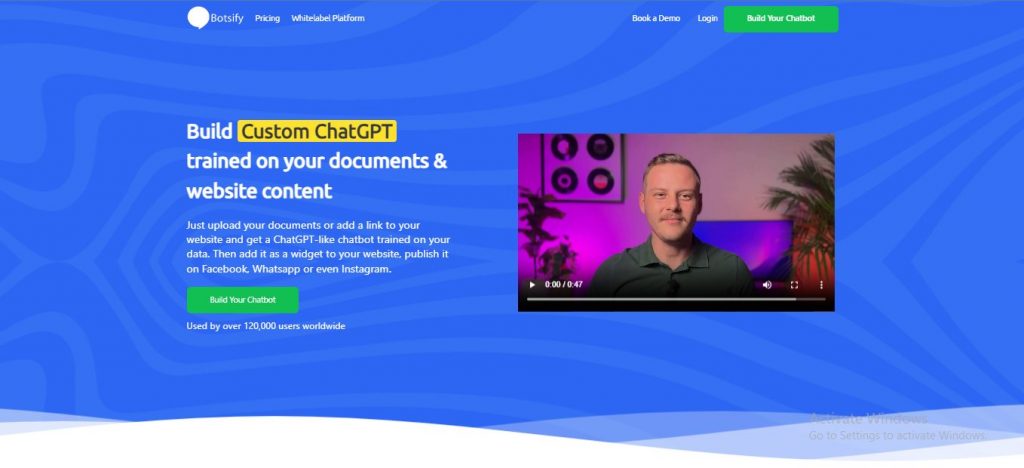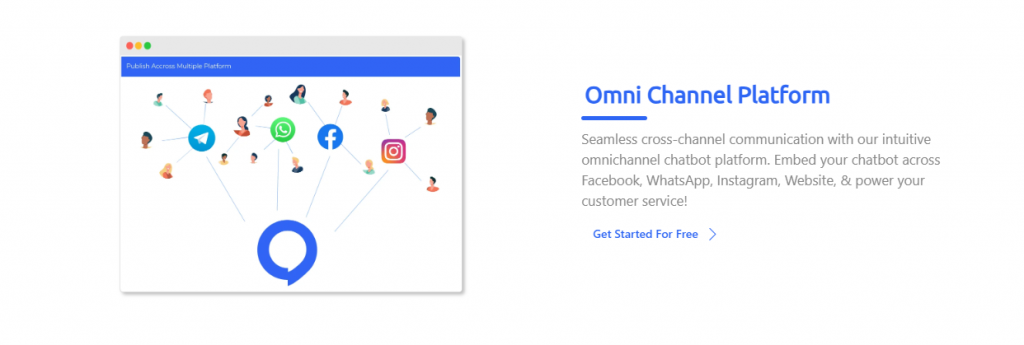In the digital age, AI chatbots are becoming increasingly popular for businesses looking to boost customer service, streamline operations, and provide round-the-clock support. ChatGPT, powered by OpenAI’s GPT-3.5 architecture, is a cutting-edge AI language model that can be employed to create highly effective chatbots. However, achieving the best results with a ChatGPT-based chatbot requires careful planning and optimization. In this article, we will delve into 10 tips for optimizing your ChatGPT AI chatbot to ensure that it not only meets but exceeds your expectations.
1. Introduction
Welcome to the ChatGPT AI Chatbot Platform, a revolutionary solution at the forefront of conversational AI. Harnessing the power of OpenAI’s GPT-3.5, The platform empowers developers and businesses to build sophisticated and context-aware chatbots. Seamlessly integrating natural language understanding, ChatGPT offers a dynamic and engaging user experience.
With its generative pre-training, it adapts to various industries, providing versatile applications from customer support to virtual assistants. Elevate your chatbot capabilities with ChatGPT AI Chatbot Platform – where innovation and intelligence converge for unparalleled conversational interactions. Welcome to the future of AI-driven communication!

2. Understanding the Basics of ChatGPT AI Chatbots
Understanding the basics of ChatGPT AI chatbots involves grasping the fundamental principles behind their design and functionality. Here are key points to consider:
- Model Architecture: ChatGPT is built on the GPT (Generative Pre-trained Transformer) architecture. It’s a deep neural network model that uses transformer architecture, allowing it to process and generate human-like text.
- Pre-training: ChatGPT is pre-trained on a vast dataset that includes a diverse range of internet text. During this phase, the model learns grammar, language structure, and contextual relationships by predicting the next word in a sentence.
- Generative Capabilities: The term “generative” refers to the model’s ability to generate coherent and contextually relevant responses. ChatGPT doesn’t rely on predefined responses but generates text based on the input it receives.
- Natural Language Understanding: ChatGPT exhibits natural language understanding, enabling it to comprehend and respond to user inputs in a way that simulates human conversation. It can handle a variety of tasks, from answering questions to engaging in open-ended dialogue.
- Context Retention: One notable feature is its ability to maintain context over multiple turns in a conversation. This contextual awareness allows for more meaningful and coherent interactions.
- Limitations: While powerful, ChatGPT has limitations. It may generate responses that are contextually incorrect or nonsensical. It also lacks real-time information access and may not always provide accurate answers, as its knowledge is based on pre-existing data up to its last training cut-off in January 2022.
Understanding these basics provides a foundation for effectively utilizing ChatGPT in creating chatbots, customer support applications, and various other conversational AI implementations. Developers can leverage its strengths while being mindful of its limitations to optimize performance.
3. Choose the Right ChatGPT Variant
Choosing the right ChatGPT variant involves considering factors such as the specific needs of your application, the scale of your project, and the level of customization required, OpenAI has released various versions of the GPT model, and here are some considerations:
- GPT-3 and GPT-3.5 Turbo: GPT-3 is the latest and most advanced version available. It offers remarkable language generation capabilities but might be overkill for simpler tasks. GPT-3.5 Turbo is a more cost-effective option with comparable performance to GPT-3 in many scenarios, making it a popular choice for many applications.
- Consider Your Budget: The cost of using these models can vary significantly. GPT-3 is more expensive to use than GPT-3.5 Turbo. Therefore, if you have budget constraints, it’s essential to evaluate the trade-off between cost and performance.
- Fine-Tuning Requirements: If your application demands highly specialized behavior or a specific domain of knowledge, you might want to explore fine-tuning. GPT-3.5 Turbo is fine-tunable, allowing you to adapt the model to your specific needs.
- Token Limits: Both GPT-3 and GPT-3.5 Turbo have token limits, meaning there’s a maximum length for the input and output text. If your conversations are lengthy, you should be mindful of these limitations.
- Experimentation and Testing: OpenAI provides a user interface for testing various prompts and interactions with ChatGPT. This can be a valuable step in evaluating the model’s performance for your specific use case.
- Community and Documentation: OpenAI has an active community and provides comprehensive documentation. It’s advisable to explore the community forums and documentation to gain insights, tips, and best practices for using ChatGPT effectively.
Generate More Leads With Website & Messenger Chatbots
Gather quality leads on autopilot and 10x your ROI with automated chats
4. Define Clear Objectives
Defining clear objectives is a crucial step in implementing any AI-based solution, including ChatGPT. Clear objectives help guide the development process, set expectations, and ensure that the application of ChatGPT aligns with your overall goals. Here are key considerations for defining clear objectives:
- Purpose and Use Case: Clearly articulate the purpose of integrating ChatGPT. Identify the specific use case or problem you intend to address, whether it’s customer support, content generation, or another application.
- Target Audience: Define the target audience or users who will interact with the ChatGPT-based system. Understanding your users’ needs and expectations is essential for tailoring the chatbot’s behavior to meet specific requirements.
- Functional Requirements: Outline the specific functionalities you expect from ChatGPT. This could include providing information, answering queries, engaging in conversations, or performing specific tasks. Be explicit about the tasks and capabilities you want the chatbot to handle.
- Performance Metrics: Establish measurable performance metrics to evaluate the success of your ChatGPT implementation. Metrics could include accuracy, response time, user satisfaction, or any other relevant key performance indicators (KPIs).
- Integration with Existing Systems: If ChatGPT is part of a larger system or platform, define how it will integrate with existing technologies and workflows. Ensure compatibility and smooth interaction with other components of your ecosystem.
- Ethical and Compliance Considerations: Address ethical considerations and ensure that the implementation adheres to legal and regulatory requirements. This includes considerations around user privacy, data security, and compliance with relevant industry standards.
- Scalability and Future Expansion: Anticipate future needs and design the ChatGPT implementation with scalability in mind. Consider whether the system should be able to handle increased user interactions or be easily expanded to accommodate additional features.
- User Experience Goals: Clearly define the desired user experience. Consider factors such as the tone of the chatbot’s responses, the level of personalization, and any specific branding or messaging guidelines.
- Training and Maintenance: Outline plans for ongoing training and maintenance of the ChatGPT model. This includes strategies for handling updates, refining the chatbot’s behavior, and addressing any emerging issues.
By defining clear objectives, you provide a roadmap for the development and deployment of ChatGPT, helping to ensure that the implementation aligns with your business goals and user expectations. Regularly revisit and update these objectives as needed based on user feedback, evolving business requirements, and advancements in technology.
5. Design a User-Friendly Interface

Designing a user-friendly interface for a ChatGPT-powered chatbot is essential to ensure a positive user experience. Here are key considerations for creating an interface that is intuitive, engaging, and effective:
- Conversational Flow: Design a natural and intuitive conversational flow that guides users through interactions. Consider the typical user journey and structure the conversation in a way that makes sense and is easy to follow.
- User Input Handling: Clearly communicate the types of inputs the chatbot can understand. Provide examples or prompts to guide users in formulating questions or requests that the chatbot can process effectively.
- Feedback and Confirmation: Implement clear and prompt feedback mechanisms. Acknowledge user inputs, provide relevant responses, and offer confirmation messages to reassure users that their queries or actions have been understood.
- Context Retention: If your chatbot is intended for multi-turn conversations, ensure that it can retain context from previous interactions. This enhances the user experience by making the conversation more coherent and personalized.
- Error Handling: Anticipate potential user errors or misunderstandings and design error-handling mechanisms. Provide helpful error messages that guide users on how to correct their input or provide additional information.
- Visual Design and Branding: Incorporate a visually appealing design that aligns with your brand. Use colors, fonts, and imagery consistently with your brand identity. A visually cohesive design contributes to a professional and polished user experience.
- User Guidance and Tips: Include on-screen tips or guidance to help users interact more effectively with the chatbot. This is particularly useful for first-time users or for introducing specific features or commands.
- Accessibility: Ensure that your interface is accessible to users with different abilities. Consider factors such as font size, color contrast, and compatibility with screen readers to make your chatbot inclusive and accessible to a diverse user base.
- Mobile Responsiveness: Design the interface to be responsive to different screen sizes, particularly for mobile devices. This ensures a seamless experience across various devices and platforms.
- User Privacy and Transparency: Clearly communicate how user data will be used and stored. Incorporate privacy features, such as the ability for users to opt out of data collection or delete their conversation history if applicable.
- User Testing: Conduct usability testing with a diverse group of users to gather feedback on the interface design. Use this feedback to identify areas for improvement and refine the design iteratively.
- By prioritizing user-friendly design principles, you enhance the accessibility and usability of your ChatGPT-powered chatbot, fostering a positive and engaging user experience. Regularly gather user feedback and make iterative improvements to the interface based on user interactions and evolving user needs.
6. Implement Natural Language Processing
Implementing Natural Language Processing (NLP) involves utilizing computational techniques to enable machines to understand, interpret, and generate human language. Key steps include tokenization, breaking down text into smaller units; part-of-speech tagging, identifying grammatical components; and named entity recognition, extracting entities like names and locations.
Syntax and semantics analysis helps understand sentence structure and meaning. Machine learning models, such as recurrent neural networks or transformers, are commonly used for NLP tasks like sentiment analysis, text classification, and language translation. Integration of pre-trained language models, such as BERT or GPT, can enhance NLP capabilities, providing contextual understanding and generating human-like text. Evaluation metrics like accuracy, precision, and recall are crucial for assessing the effectiveness of NLP implementations.
7. Train Your ChatGPT Effectively
Training ChatGPT effectively involves providing diverse and relevant data to fine-tune the model for specific use cases. Clearly define the objectives and desired behavior of the chatbot during the fine-tuning process. Use a balanced dataset that reflects the expected variety of user inputs.
Experiment with different prompts to guide the model’s behavior and iteratively refine its responses. Monitor and address biases in the training data to ensure fair and unbiased outcomes. Regularly assess the model’s performance using appropriate evaluation metrics and incorporate user feedback for continuous improvement. Fine-tuning should be an ongoing process to adapt to evolving user needs and enhance the chatbot’s effectiveness over time.
8. Continuous Monitoring and Feedback
Continuous monitoring and feedback are essential components of maintaining a high-performance ChatGPT system. Implement real-time monitoring tools to track user interactions, system performance, and potential issues. Establish feedback loops with users to gather insights into their experiences and improve the chatbot’s responses. Regularly review and update the training data to address emerging patterns or biases. Monitor for ethical considerations, such as inappropriate content generation, and implement safeguards accordingly.
Utilize key performance indicators (KPIs) to assess the effectiveness of the chatbot, and adapt its behavior based on ongoing feedback and evolving user requirements. This iterative process ensures that the chatbot remains responsive, accurate, and aligned with user expectations over time.
9. Optimize for Multi-Channel Integration

Optimizing for multi-channel integration involves ensuring seamless deployment of ChatGPT across various communication channels. Design the chatbot’s interface to be adaptable and responsive across web, mobile, and other platforms. Implement consistent branding and user experiences across channels for a cohesive interaction.
Integrate with popular messaging platforms, communication tools, and email marketing software to broaden the chatbot’s reach. Tailor responses and functionalities are based on the unique characteristics of each channel. Monitor user engagement and feedback across different channels to identify areas for improvement and optimization. This approach ensures a unified and effective presence of ChatGPT across diverse communication channels.
10. Security and Privacy Considerations
Security and privacy considerations are paramount when implementing ChatGPT. Employ robust encryption protocols to protect user data during communication. Implement access controls and authentication mechanisms to restrict unauthorized access to the chatbot system.
Regularly update and patch software to address vulnerabilities and maintain a secure infrastructure. Adhere to data protection regulations and industry standards to safeguard user privacy. Minimize data retention and anonymize user data where possible to mitigate privacy risks. Conduct regular security audits and assessments to identify and address potential vulnerabilities, ensuring a secure and privacy-conscious deployment of ChatGPT. Additionally, implement a program for regular user access review to ensure that only authorized personnel have access to sensitive user data.
Conclusion
In conclusion, optimizing your ChatGPT AI chatbot involves a multi-faceted approach, including careful planning, continuous monitoring, and user feedback. By following these 10 tips, you can create a highly effective and efficient chatbot that provides valuable support and enhances user experiences.
Are You Ready To SkyRocket Your Business With Our AI Chatbots
Click The Button Below And Gather Quality Leads With Botsify
FAQs
1. What is ChatGPT?
ChatGPT is a powerful AI language model developed by OpenAI, used for creating chatbots and providing natural language understanding.
2. How can I choose the right ChatGPT variant for my project?
Select the ChatGPT variant that best matches your project’s objectives, budget, and expected usage.
3. Why is user-friendly interface design important for a chatbot?
A user-friendly interface ensures that users can easily interact with the chatbot, leading to a better user experience.
4. How can I ensure the security and privacy of user data in my chatbot?
Implement robust security measures, data encryption, and privacy policies to protect user information.
5. Why is continuous monitoring and feedback essential for chatbot optimization?
Regular monitoring and user feedback help identify areas for improvement and maintain the chatbot’s effectiveness.


